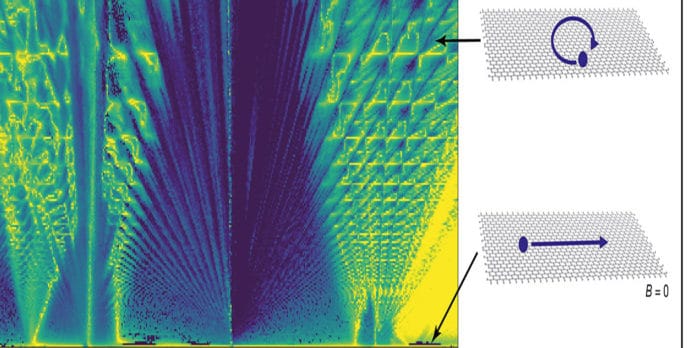Aligning the atomic lattice of a graphene layer to that of an insulating boron nitride sheet drastically changes the graphene sheet’s properties. By doing this, scientists at The University of Manchester have discovered and characterized a new family of quasiparticles. They name this new family as ‘Brown-Zak fermions’ in graphene-based superlattices.
In reality, the study follows years of successive advances in graphene-boron nitride superlattices. Those advances allowed scientists to observe a fractal pattern known as Hofstadter’s butterfly. Scientists found another highly surprising behavior of particles in such structures under the applied magnetic field.
Julien Barrier and Dr. Piranavan Kumaravadivel, who carried out the experimental work, explained, “It is well known that electrons move in straight trajectories in zero magnetic fields and if you apply a magnetic field they start to bend and move in circles.”
“In a graphene layer which has been aligned with the boron nitride, electrons also start to bend – but if you set the magnetic field at specific values, the electrons move in straight line trajectories again, as if there is no magnetic field anymore!”
“Such behavior is radically different from textbook physics.”
Dr. Alexey Berdyugin said, “We attribute this fascinating behavior to the formation of novel quasiparticles at the high magnetic field. Those quasiparticles have their unique properties and exceptionally high mobility despite the extremely high magnetic field.”
Until now, collective electrons’ behavior in graphene superlattices was thought in terms of the Dirac fermion, a quasiparticle that has extraordinary properties looking like photons (particles with no mass) that replicate at high magnetic fields. Nonetheless, this didn’t represent some experimental features, similar to the states’ additional degeneracy, nor did it match the finite mass of the quasiparticle in this state.
The authors propose ‘Brown-Zak fermions’ to be the family of quasiparticles existing in superlattices under a high magnetic field. This is characterized by a new quantum number that can directly be measured. Interestingly, working at lower temperatures allowed them to lift the degeneracy with exchange interactions at ultra-low temperatures.
Scientists noted, “Under the presence of a magnetic field, electrons in graphene start rotating with quantized orbits. We managed to restore tens of micrometers straight trajectory under high magnetic fields up to 16T (500,000 times earth’s magnetic field) for Brown-Zak fermions. Under specific conditions, the ballistic quasiparticles feel no effective magnetic field.”
Dr. Kumaravadivel said, “For this study, we prepared graphene devices that are extra-large with a very high level of purity. This allowed us to achieve mobilities of several millions of cm²/Vs, which means particles would travel straight across the entire device without scattering. Importantly, this was not only the case for classical Dirac fermions in graphene but also realized for the Brown-Zak fermions reported in work.”
These Brown-Zak fermions define new metallic states that are generic to any superlattice system, not just graphene, and offer a playground for new condensed matter physics problems in other 2D material-based superlattices.
Julien Barrier added, “The findings are important, of course, for fundamental studies in electron transport, but we believe that understanding quasiparticles in novel superlattice devices under high magnetic fields can lead to the development of new electronic devices.”
Journal Reference:
- Barrier, J., Kumaravadivel, P., Krishna Kumar, R. et al. Long-range ballistic transport of Brown-Zak fermions in graphene superlattices. Nat Commun 11, 5756 (2020). DOI: 10.1038/s41467-020-19604-0
